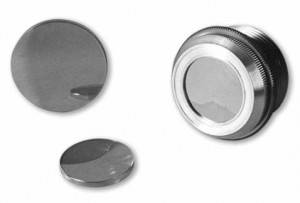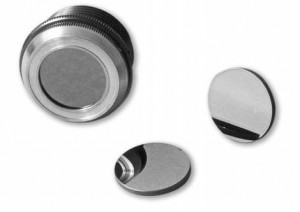Laser CO2 Lenses
Lenses are used in most CO2 laser systems to focus all the beam’s power into a very small spot. Small, focused spot size is important for a couple of reasons: cutting, welding and heat treating generally call for high-power density, and power density is a strong function of spot size. (Reduce the spot diameter by 50% and the power density increases by 200%.) Also, many jobs demand narrow kerf widths and heat affected zones, which can only be achieved with a tightly focused beam.
The design variables that will affect the performance of a CO2 laser lens are: focal length, diameter, shape, material and coating.
Focal Length
Focal length affects both spot size and depth of focus. In general, a shorter focal length will produce a smaller focused spot and a shorter depth of focus. Usually, the specified focal length is a compromise between desired spot size, penetration depth and workpiece clearance.
Lens Diameter
Higher power lasers require larger diameter lenses to prevent thermal overload. At any given focal length, a larger diameter lens will yield a smaller focused spot if the incoming beam is expanded to fill the larger lens.
Lens Shapes
Plano-convex is the simplest and least expensive lens shape. It is used in such applications as welding where achieving the smallest spot size is not critical, or at relatively long focal lengths when more complex shapes would not be beneficial. A plano-convex lens should be oriented with the flat side toward the workpiece and the convex side toward the laser. Meniscus lenses have a concave curve on one side and a convex curve on the other. At relatively short focal lengths, a meniscus lens will yield a smaller focused spot than a plano-convex lens. However, meniscus lenses are more expensive to manufacture than plano-convex lenses because both sides are curved. A meniscus lens should be oriented with the concave curve toward the workpiece.
Zinc Selenide plano-convex lenses

Zinc Selenide (ZnSe) has the lowest absorption of the common CO2 transmitting materials and is, therefore, the material of choice for high-power applications. It is also the only material that transmits visible light, a requirement for the use of a HeNe alignment laser.
Gallium Arsenide plano-convex lenses

Gallium Arsenide (GaAs) is the material of choice in dirty or high- splatter environments. It has relatively high hardness which helps repel debris particles. It also has high thermal conductivity which helps transmit heat away from imbedded particles.
Germanium (Ge) can only be used in low power applications because it is subject to thermal runaway. As temperature increases, its absorption increases, which leads to thermal failure in high power applications. Ge used to be the lowest cost CO2 lens material because its widespread use in the semiconductor industry created a large supply. However, the demand for ZnSe for high power laser applications has increased the supply of ZnSe so greatly that Ge is not always the least expensive lens material.
ZnSe Lenses for High Pressure Applications
When high pressure assist gases are employed to increase laser cutting speeds, extra thick lenses must be used to prevent lens distortion or breakage. ZnSe is the preferred substrate material for extra thick lenses because most applications requiring high pressure assist gas also require high laser power.
